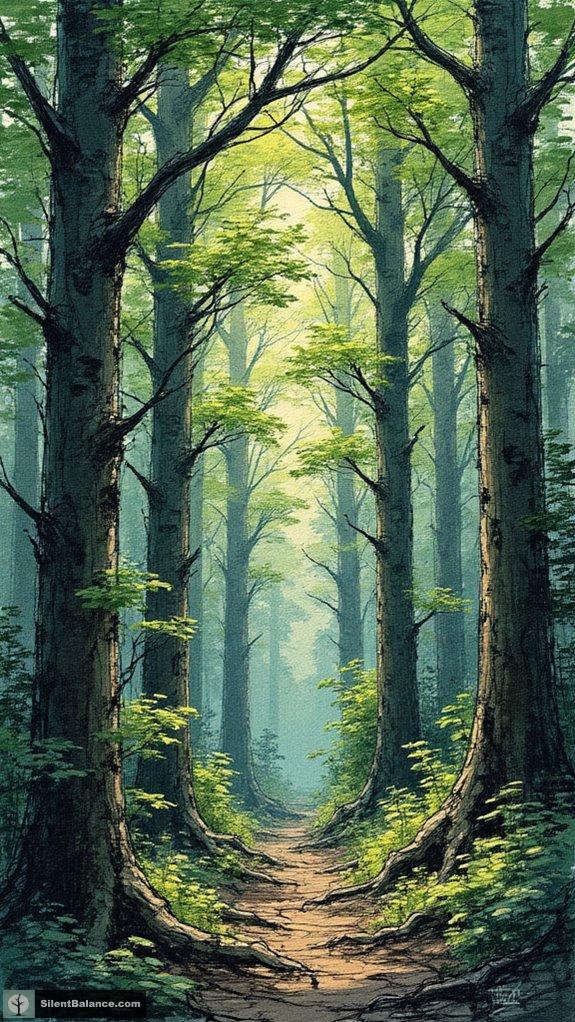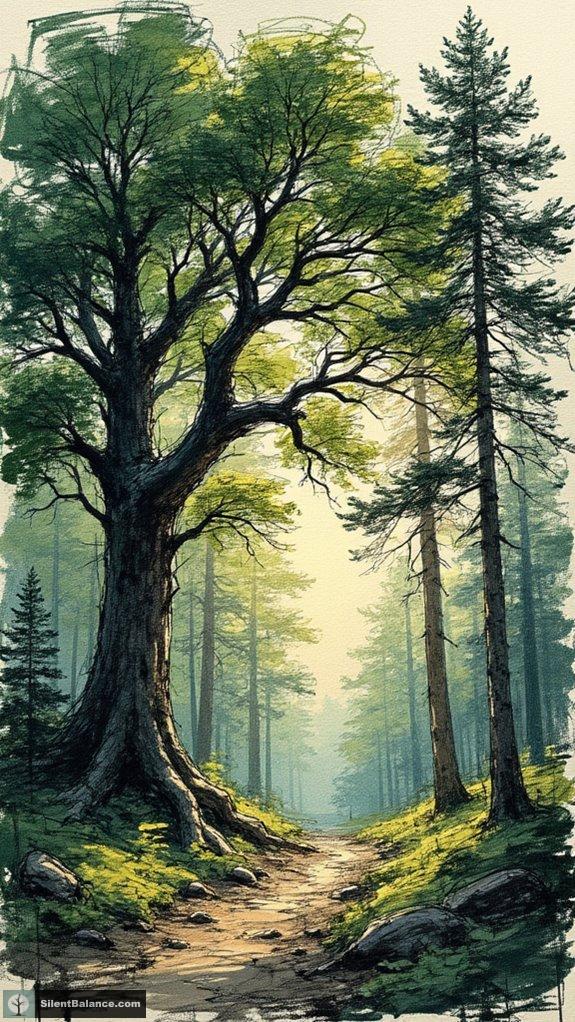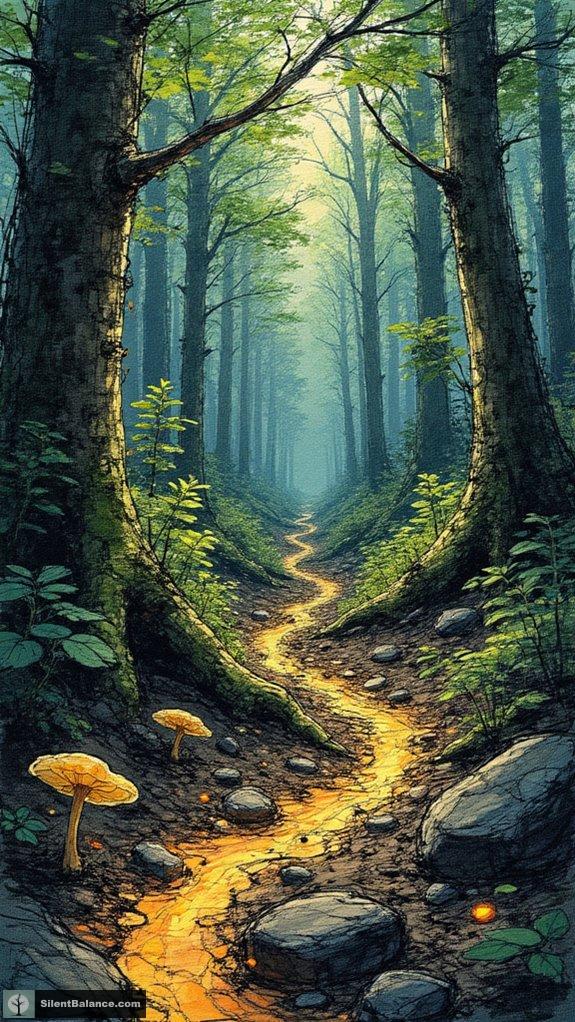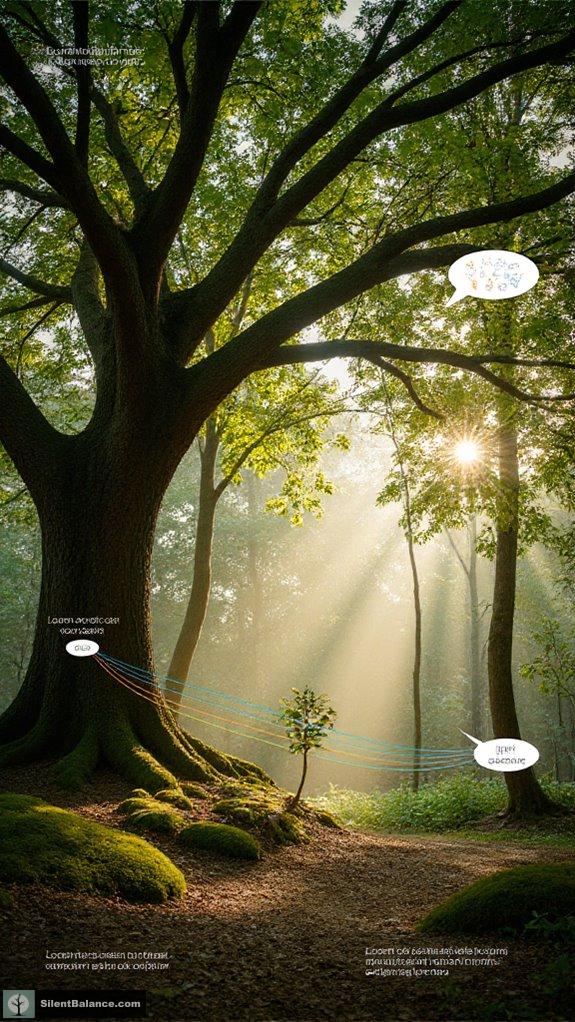Trees use chemical signals to juggle cooperation and competition in their communities. When faced with threats, they release distress signals through volatile organic compounds, rallying help from nearby trees. Meanwhile, mycorrhizal networks act like the wood-wide web, sharing nutrients and resources, especially among kin. But don’t get it twisted—when competition heats up, trees can drop allelopathic chemicals to eliminate rivals. Intrigued by how this dynamic dance plays out in the forest? There’s more to explore!
Quick Takeaways
- Trees communicate their needs and threats through volatile organic compounds (VOCs), signaling cooperation among nearby trees for defense and resource sharing.
- Mycorrhizal networks enable nutrient and water exchange, showcasing cooperative behavior between larger trees and their struggling saplings or kin.
- Kin recognition occurs via root exudates, prompting trees to preferentially allocate resources to relatives, reinforcing familial cooperation.
- Allelopathic chemicals are released by trees to suppress competition, indicating a shift towards self-preservation and competitive strategies for resource dominance.
- The balance between cooperative resource sharing and competitive tactics dictates forest dynamics, influencing community resilience and ecosystem health.
Chemical Signals and Tree Defense Mechanisms

When you think about trees, don’t you just picture them standing tall, soaking up sunlight? But guess what—they’re not just passive sentinels; they’ve got some serious defensive swag going on!
Trees use chemical signals like salicylic and jasmonic acids to kick their defense into high gear. Ever seen a leaf get munched on? That herbivore’s saliva sends a SOS, cranking up defense hormones, like tannins, to make those leaves less tasty. In addition to these hormones, trees also produce terpenes and phenolics that help deter herbivores and pathogens. Furthermore, some tree species use root networks to share resources and enhance their mutual defenses against threats.
And the wild part? Trees communicate with one another through volatile organic compounds, kind of like how we’d text a friend for backup.
Seeing a neighbor get attacked? They’ll rally the squad to fight back. It’s truly a tree-tastic world of cooperation and competition!
Mycorrhizal Networks: The Wood-Wide Web

Envision walking through a forest, where hidden connections thrive beneath your feet—this is the magic of mycorrhizal networks, or what some might call the “Wood-Wide Web.”
While trees might look like solitary giants, they’re actually part of a bustling underground community, and they’re not the lone wolves of the plant world you might think. These networks let trees swap nutrients like carbon and water, giving struggling saplings a boost when they need it most. Through these networks, trees can facilitate the transfer of nutrients and signals to ensure survival during challenging times.
Additionally, trees can communicate their needs and distress through volatile organic compounds, which can signal neighboring trees to prepare for impending threats or shortages.
Ever heard of mother trees? They’re the matriarchs, linking other trees and sharing sweet supports like sugar.
Plus, they send distress signals—like a friend saying, “Hey, I got your back!”
Kin Recognition and Selective Resource Support

Envision strolling through a sun-dappled glade, where every tree isn’t just standing tall but also engaging in a silent conversation beneath the soil. Isn’t that wild?
These trees recognize their kin, thanks to nifty root exudates that play a crucial part in their cooperative behaviors. When they’re close relatives, these trees allocate precious resources like nutrients and water preferentially to each other. They adjust their growth patterns to boost collective fitness—talk about family support! Kin recognition in plants ultimately enhances their ability to thrive in competitive environments, reinforcing the bonds between family members.
It’s almost like having your crew’s back in the tattoo scene, where inked pals help each other out, right?
Community Defense Through Collective Signaling

Who would’ve thought that trees, those seemingly quiet giants of the forest, have their own covert ways of keeping the crew safe?
When trouble rolls in, like a hungry herbivore or sneaky pathogen, trees send chemical signals—think of them as nature’s “tattoos” of warning. These signals zip through the air or via underground mycorrhizal networks, alerting neighbors to gear up their defenses. Ever seen acacia trees puff out ethylene gas? That’s their way of rallying the troops to chug out tannins, making those tasty leaves less appealing. Trees also engage in underground communication through mycorrhizal fungi, allowing them to share vital resources during stressful times.
It’s a full-on fortress vibe in the forest, where every tree has each other’s back, working in harmony.
Environmental Stress Responses and Adaptive Cooperation

When faced with the trials of a changing environment, trees don’t just sit back and accept their fate—they adapt and cooperate in ways that might surprise you.
Ever heard of epigenetic memory? It lets trees respond quickly to stress like drought or heat without messing with their DNA. Talk about flexibility! This memory primes them to bounce back better next time, boosting survival rates of species like *Eucalyptus camaldulensis*. Epigenetic adjustments enable trees to cope with fluctuating climatic conditions, allowing for a robust response to environmental changes.
Under stress, trees adjust, growing deeper roots or taller canopies to thrive together.
So, what’s the takeaway? Trees show us how cooperative strategies can evolve when the going gets tough, transforming competition into a collective survival dance.
Feeling inspired by their fearless approach? You should be!
Competitive Interactions: Allocating Resources in Dense Forests

In dense forests, surprisingly intense competition unfolds beneath the canopy, impacting how trees allocate resources.
You see, when water and soil nutrients are plentiful, trees amp up their growth, causing a scramble for light and space. It’s a real battle out there!
Smaller trees often get the short end of the stick, being overshadowed and squeezed for resources. Shade-intolerant species? They really feel it, shrinking under competitive stress while their tougher cousins thrive.
And speaking of space, tight stands limit access to nutrients, forcing trees to position their roots strategically—trees ain’t just standing around!
Give them a bit of breathing room, though, and watch how increasing spacing can help ease these struggles, enhancing stability and sap flow. It’s a wild game of survival!
Balancing Cooperation and Competition in Tree Communities

While competition often steals the spotlight in dense forests, the world of trees isn’t just about who gets to the top first.
You see, trees engage in a delicate dance of cooperation and competition. Sometimes, they team up, boosting each other’s growth and sharing nutrients like best buds at a BBQ.
Other times, they’re in full-on resource battles, scrambling for light like it’s the last drink at a party.
Environmental conditions play a huge role, flipping the script from competition to cooperation when the going gets tough.
Ever notice how trees can help each other thrive in harsh spots?
Science of Mycorrhizal Networks and Soil Communication

You mightn’t realize it, but beneath the forest floor lies a complex network of connections that rivals any urban grid.
These mycorrhizal networks, or CMNs, link plant roots with fungal hyphae, creating an underground highway for communication and nutrient sharing.
Envision plants shooting nutrients to their buddies across the network, like exchanging snacks at a party. Rhizomorphs, those groovy clusters of hyphae, transport not just nutrients, but also essential signals during crises, like a warning text when danger’s near.
These networks enhance soil structure and optimize nutrient access, ensuring plants thrive together.
Tree Communication Signals Competition Versus Cooperation

When you step into a forest, it’s not just the towering trees and the rustling leaves that catch your eye—there’s a whole conversation happening beneath that green canopy, blending cooperation and competition in a remarkable dance.
Imagine this:
- Trees sending out chemical signals like a buddy texting for backup when pests attack.
- A nutrient hand-off, where a big tree shares goodness with a struggling sapling, kind of like an older sibling looking out for a younger one.
- The sneaky allelopathic chemicals sent out to kick out competition, ensuring a tree’s dominance in its turf.
This forest dialogue keeps trees thriving, figuring out when to cooperate and when to compete—like maneuvering a winding road to freedom in their ecosystem.
Questions and Answers
How Do Human Activities Impact Tree Signaling Cooperation or Competition?
Human activities? Oh, they really flip the script on tree signaling.
When you clear-cut a forest, it’s like ripping out the connection cables on a dope tattoo machine. Trees can’t share resources, and that leads to competition for light and nutrients.
Pollution? It muddles their chemical chat, making it hard for trees to warn their buddies about pests.
Sustainable practices, though, can get those roots high-fiving again—who wouldn’t want healthier, happier trees?
Do Different Tree Species Communicate in the Same Way?
You might think all trees chat in the same tongue, right? Nope! Different tree species have their own unique ways of communicating, kinda like how each tattoo artist has their signature style.
For instance, pines and elms release specific scents when under attack, each attracting its own crew of helpful wasps.
From volatile organic compounds to mycorrhizal networks, each tree’s got its vibe.
Can Trees Respond to Signals From Distant Locations?
Absolutely, trees can totally respond to signals from far-off places! They’ve got this rad system where they use xylem and phloem to send signals like hormones and nutrients.
Think of it as their own underground network, kind of like a tattoo shop buzzing with ideas!
So, when things heat up, like a drought or pest invasion, trees communicate to adjust their growth or ramp up defenses.
Pretty cool, right? They’re all about that teamwork!
What Role Does Soil Composition Play in Tree Interactions?
Soil composition plays a massive role in how trees vibe with each other, right?
Think about how nutrient-rich soils boost growth but can also kick off fierce competition.
You’re looking at clay content and pH effects influencing nutrient uptake, which can shape tree interactions.
It’s like an underground tattoo network; trees might share resources or throw down depending on their soil vibe.
Why not hop into your backyard and see how your trees connect with their soil scene?
How Does Climate Change Affect Tree Cooperation and Competition Dynamics?
Climate change cranks up competition, often forcing trees to duke it out for dwindling resources.
As heat rises, photosynthesis falters and trees stress. Ever felt the weight of pressure? Well, trees do, too! They find themselves battling for water, light, and nutrients, sometimes cooperating, but often competing fiercely.
Can you feel the tension? It’s a wild world out there, where survival’s the name of the game, and only the thick-skinned thrive!
Summary
So, what’s the deal with trees and their signals? It turns out they’re not just silent giants; they’re social networks in disguise! Did you know that about 90% of trees rely on mycorrhizal networks to thrive? That’s like each tree having its own underground support squad! As they navigate competition and cooperation, these leafy legends make it clear that teamwork really does make the dream work. Next time you see a forest, think of all the hidden connections at play!
References
- https://www.bloomandsong.com/hong-kong-wedding-flowers/the-secret-lives-of-trees-communication-and-defense-mechanisms
- https://www.smithsonianmag.com/science-nature/the-whispering-trees-180968084/
- https://one-more-tree.org/blog/2025/04/04/what-do-trees-say-to-the-world-plant-communication-through-underground-mycorrhizal-networks/
- https://wildlife.org.au/exploring-the-secret-world-of-trees-and-their-communication-networks/
- https://hittingclosetoom.com/competition-or-cooperation-what-trees-teach-us-about-connection/
- https://www.numberanalytics.com/blog/tree-defense-mechanisms
- https://en.wikipedia.org/wiki/Plant_defense_against_herbivory
- https://www.sciencedaily.com/releases/2022/03/220310115124.htm
- https://www.doctorkiltz.com/plant-defense-mechanisms/
- https://pmc.ncbi.nlm.nih.gov/articles/PMC4497361/
- https://en.wikipedia.org/wiki/Mycorrhizal_network
- https://www.nationalforests.org/blog/underground-mycorrhizal-network
- https://nph.onlinelibrary.wiley.com/doi/10.1111/nph.18935
- https://pmc.ncbi.nlm.nih.gov/articles/PMC9428624/
- https://pmc.ncbi.nlm.nih.gov/articles/PMC8048686/
- https://en.wikipedia.org/wiki/Kin_recognition
- https://www.frontiersin.org/journals/ecology-and-evolution/articles/10.3389/fevo.2021.785019/full
- https://www.nature.com/articles/s41438-021-00598-9
- https://link.springer.com/article/10.1007/s40725-023-00201-5
- https://pmc.ncbi.nlm.nih.gov/articles/PMC10463331/
- Bonsai Placement Benefits for Room Harmony - November 8, 2025
- Why Use Air Layering to Propagate Bonsai Trees? - November 8, 2025
- 15 Stunning Acorn Wood Wall Art Ideas - November 8, 2025

